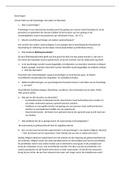Samenvatting
Summary Workshops Loss & Psychotrauma
- Vak
- Instelling
This summary contains all articles for the workshops given in the course Loss & Psychotrauma. It also contains notes from the workshops and the slides. The following workshops are included: Workshop: Narrative Exposure Therapy - Josita Versteeg Article: Narrative exposure therapy for PTSD p...
[Meer zien]












